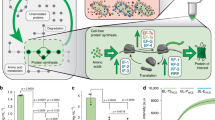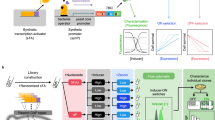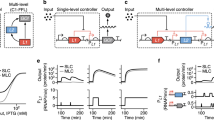Abstract
De novo-designed proteins1,2,3 hold great promise as building blocks for synthetic circuits, and can complement the use of engineered variants of natural proteins4,5,6,7. One such designer protein—degronLOCKR, which is based on ‘latching orthogonal cage–key proteins’ (LOCKR) technology8—is a switch that degrades a protein of interest in vivo upon induction by a genetically encoded small peptide. Here we leverage the plug-and-play nature of degronLOCKR to implement feedback control of endogenous signalling pathways and synthetic gene circuits. We first generate synthetic negative and positive feedback in the yeast mating pathway by fusing degronLOCKR to endogenous signalling molecules, illustrating the ease with which this strategy can be used to rewire complex endogenous pathways. We next evaluate feedback control mediated by degronLOCKR on a synthetic gene circuit9, to quantify the feedback capabilities and operational range of the feedback control circuit. The designed nature of degronLOCKR proteins enables simple and rational modifications to tune feedback behaviour in both the synthetic circuit and the mating pathway. The ability to engineer feedback control into living cells represents an important milestone in achieving the full potential of synthetic biology10,11,12. More broadly, this work demonstrates the large and untapped potential of de novo design of proteins for generating tools that implement complex synthetic functionalities in cells for biotechnological and therapeutic applications.
This is a preview of subscription content, access via your institution
Access options
Access Nature and 54 other Nature Portfolio journals
Get Nature+, our best-value online-access subscription
$29.99 / 30 days
cancel any time
Subscribe to this journal
Receive 51 print issues and online access
$199.00 per year
only $3.90 per issue
Buy this article
- Purchase on Springer Link
- Instant access to full article PDF
Prices may be subject to local taxes which are calculated during checkout




Similar content being viewed by others
Data availability
All data that support the findings of this study are available within the Letter and its Supplementary Information. Original data that supports the findings are available from the corresponding author upon reasonable request. Plasmids that encode the synthetic controller and process are available from Addgene (plasmids 127164 and 127165).
Code availability
Code that supports the findings of this study is available at https://github.com/andrewng1023/NatureFeedbackdegronLOCKR.
Change history
25 February 2020
An amendment to this paper has been published and can be accessed via a link at the top of the paper.
References
Boyken, S. E. et al. De novo design of protein homo-oligomers with modular hydrogen-bond network-mediated specificity. Science 352, 680–687 (2016).
Huang, P.-S., Boyken, S. E. & Baker, D. The coming of age of de novo protein design. Nature 537, 320–327 (2016).
Chen, Z. et al. Programmable design of orthogonal protein heterodimers. Nature 565, 106–111 (2019).
Andrews, L. B., Nielsen, A. A. K. & Voigt, C. A. Cellular checkpoint control using programmable sequential logic. Science 361, eaap8987 (2018).
Toda, S., Blauch, L. R., Tang, S. K. Y., Morsut, L. & Lim, W. A. Programming self-organizing multicellular structures with synthetic cell–cell signaling. Science 361, 156–162 (2018)
Gao, X. J., Chong, L. S., Kim, M. S. & Elowitz, M. B. Programmable protein circuits in living cells. Science 361, 1252–1258 (2018).
Bashor, C. J. et al. Complex signal processing in synthetic gene circuits using cooperative regulatory assemblies. Science 364, 593–597 (2019).
Langan, R. et al. De novo design of bioactive protein switches. Nature https://doi.org/10.1038/s41586-019-1432-8 (2019).
Aranda-Díaz, A., Mace, K., Zuleta, I., Harrigan, P. & El-Samad, H. Robust synthetic circuits for two-dimensional control of gene expression in yeast. ACS Synth. Biol. 6, 545–554 (2017).
Briat, C., Gupta, A. & Khammash, M. Antithetic integral feedback ensures robust perfect adaptation in noisy biomolecular networks. Cell Syst. 2, 15–26 (2016).
Del Vecchio, D., Dy, A. J. & Qian, Y. Control theory meets synthetic biology. J. R. Soc. Interface 13, 20160380 (2016).
Aoki, S. K. et al. A universal biomolecular integral feedback controller for robust perfect adaptation. Nature 570, 533–537 (2019).
Hoyt, M. A., Zhang, M. & Coffino, P. Ubiquitin-independent mechanisms of mouse ornithine decarboxylase degradation are conserved between mammalian and fungal cells. J. Biol. Chem. 278, 12135–12143 (2003).
Bardwell, L. A walk-through of the yeast mating pheromone response pathway. Peptides 26, 339–350 (2005).
McCullagh, E., Seshan, A., El-Samad, H. & Madhani, H. D. Coordinate control of gene expression noise and interchromosomal interactions in a MAP kinase pathway. Nat. Cell Biol. 12, 954–962 (2010).
Chen, R. E., Patterson, J. C., Goupil, L. S. & Thorner, J. Dynamic localization of Fus3 mitogen-activated protein kinase is necessary to evoke appropriate responses and avoid cytotoxic effects. Mol. Cell. Biol. 30, 4293–4307 (2010).
Harrigan, P., Madhani, H. D. & El-Samad, H. Real-time genetic compensation defines the dynamic demands of feedback control. Cell 175, 877–886 (2018).
Lee, M. E., DeLoache, W. C., Cervantes, B. & Dueber, J. E. A highly characterized yeast toolkit for modular, multipart assembly. ACS Synth. Biol. 4, 975–986 (2015).
Renicke, C., Schuster, D., Usherenko, S., Essen, L.-O. & Taxis, C. A LOV2 domain-based optogenetic tool to control protein degradation and cellular function. Chem. Biol. 20, 619–626 (2013).
Ma, W., Trusina, A., El-Samad, H., Lim, W. A. & Tang, C. Defining network topologies that can achieve biochemical adaptation. Cell 138, 760–773 (2009).
Bashor, C. J., Helman, N. C., Yan, S. & Lim, W. A. Using engineered scaffold interactions to reshape MAP kinase pathway signaling dynamics. Science 319, 1539–1543 (2008).
Wei, P. et al. Bacterial virulence proteins as tools to rewire kinase pathways in yeast and immune cells. Nature 488, 384–388 (2012).
Lim, W. A. & June, C. H. The principles of engineering immune cells to treat cancer. Cell 168, 724–740 (2017).
Zhang, F., Carothers, J. M. & Keasling, J. D. Design of a dynamic sensor-regulator system for production of chemicals and fuels derived from fatty acids. Nat. Biotechnol. 30, 354–359 (2012).
Moore, G. E. Progress in digital integrated electronics. In International Electron Devices Meeting, IEEE 11–13 (1975).
Acknowledgements
We thank W. Lim, O. Weiner, and M. Lajoie for helpful discussions and P. Harrigan for assistance with hardware. This work was supported by the Defense Advanced Research Projects Agency, Contract No. HR0011-16-2-0045 to H.E.-S. The content and information does not necessarily reflect the position or the policy of the government, and no official endorsement should be inferred. H.E.-S. is a Chan-Zuckerberg investigator. A.H.N. was supported by the Department of Defense (DoD) through the National Defense Science & Engineering Graduate Fellowship (NDSEG) Program. R.A.L. was supported by Bruce and Jeannie Nordstrom, thanks to the Patty and Jimmy Barrier Gift for the Institute for Protein Design Directors Fund. S.E.B. is supported by a Career Award at the Scientific Interface from Burroughs Wellcome Fund.
Author information
Authors and Affiliations
Contributions
A.H.N. and H.E.-S. conceived the study and designed all experiments. T.H.N. performed dynamic experiments. A.H.N. performed all other experiments. M.G.-S., A.H.N. and H.E.-S. conceived the computational model. M.G.-S. performed all numerical simulations. G.D. contributed to plasmid and strain construction. R.A.L., S.E.B. and D.B. designed degronLOCKR and gave feedback throughout. J.A.S., L.M.W. and J.E.D. contributed to the construction of mating-pathway strains. A.H.N. and H.E.-S. wrote the manuscript and all authors edited and approved the manuscript.
Corresponding author
Ethics declarations
Competing interests
R.A.L., A.H.N., S.E.B., D.B. and H.E.-S. have filed a provisional patent application describing the design, composition and function of degronLOCKR constructs. R.A.L., A.H.N., S.E.B., D.B. and H.E.-S. have filed a provisional patent application describing the degronLOCKR-based molecular feedback circuits. D.B. and S.E.B. hold equity in Lyell Immunopharma.
Additional information
Publisher’s note: Springer Nature remains neutral with regard to jurisdictional claims in published maps and institutional affiliations.
Extended data figures and tables
Extended Data Fig. 1 Panel of mating-pathway regulators tested with degronLOCKR.
DegronSwitch was fused to the C terminus of the endogenous copy of each regulator. The key with or without a SV40 NLS was expressed using a progesterone (Pg)-inducible system8. Ste20, Ste11 and Ptp3 were degraded using a cytoplasmic key (key–CFP), and Msg5, Ste12, Dig1 and Dig2 were degraded using a nuclear key (key–CFP–NLS). Fus3 was degraded using either a cytoplasmic or a nuclear key. Cells were induced with 1 nM (low) or 100 nM (high) α-factor and 50 nM or 0 nM progesterone, and grown for 4 h before YFP fluorescence was measured using a flow cytometer. Data represent mean ± s.d. of three biological replicates.
Extended Data Fig. 2 Dynamic measurements of the mating pathway with synthetic feedback.
DegronSwitch was fused to the C terminus of the endogenous copy of Ste12 (left) and Fus3 (right). Measurements of pAGA1-YFP-cODC dynamics for synthetic negative (left) and positive (right) feedback. Synthetic feedback and no-feedback (pREV1-key-CFP-NLS) strains were induced with 25, 12.5, 6.25 or 3.13 nM α-factor at 0 h, and flow cytometry measurements (points) were performed every 10 min. Points represent the mean ± s.d. of three biological replicates. Lines represent a moving average taken over three data points.
Extended Data Fig. 3 Model analysis of synthetic transcriptional circuit with degronLOCKR feedback to probe steady-state solutions in response to positive or negative disturbances.
a, b, Steady-state values of model variables as progesterone (a) or Z3PM degradation rate (γZ) (b) change (see ‘Model description’ in Supplementary Information). Continuous lines correspond to the feedback system (FB), and the dashed lines show an example in which the feedback has been removed (no FB; that is, fK = μK* instead of equation (12) in Supplementary Information). The grey box delimits the area in which the feedback is considered to be ‘active’. This is defined by the relative change in total GEM (Δ(G + C)/(G + C)) over the relative change of the disturbance (ΔP/P for a or ΔγZ/γZ for b) being higher than 0.15. In the absence of feedback, Δ(G + C) is equal to zero for any disturbance, unless the disturbance directly affects the synthesis or degradation rate of the key or GEM. The parameters used, and definitions of variables and species, are provided in the Supplementary Information.
Extended Data Fig. 4 Experimental behaviour of synthetic transcriptional circuit with degronLOCKR feedback as a function of progesterone for a fixed dose of oestradiol.
a, Comparison of behaviour of the steady-state circuit (ten hours after stimulation) with and without feedback (pRNR2-key-CFP-NLS) as a function of progesterone at all concentrations of oestradiol (E2). YFP fluorescence is the output of the circuit and RFP fluorescence is a proxy for Z3PM concentration. Points represent mean ± s.d. of three biological replicates. b, Example of gating strategy used to generate flow cytometry data. The cells that were used are in Q2.
Extended Data Fig. 5 Experimental behaviour of synthetic transcriptional circuit with degronLOCKR feedback as a function of oestradiol for a fixed dose of progesterone.
Comparison of the behaviour of the steady-state circuit (ten hours after stimulation) with and without feedback (pRNR2-key-CFP-NLS) as a function of oestradiol at all concentrations of progesterone. YFP fluorescence is the output of the circuit and RFP fluorescence is a proxy for Z3PM concentration. Points represent mean ± s.d. of three biological replicates.
Extended Data Fig. 6 Behaviour of synthetic transcriptional circuit with degronLOCKR feedback cannot be matched by constitutively expressing different amounts of the key.
Comparison of the behaviour of the steady-state circuit (ten hours after stimulation) with feedback, and various levels of expression of the key without feedback (REV1, RNR2, RET2 and RPL18B promoters), as a function of progesterone at a fixed concentration of 7.5 nM oestradiol. YFP fluorescence is the output of the circuit and RFP fluorescence is a proxy for Z3PM concentration. The yellow line in the top panel is the YFP output for the feedback circuit, and the red line in the bottom panel is the RFP output for the feedback circuit. Points represent mean ± s.d. of three biological replicates. Data points are connected by lines to guide the eye.
Extended Data Fig. 7 Model analysis of synthetic transcriptional circuit with degronLOCKR feedback to probe the effect of changing η+ or μK on steady state solution & feedback activity.
a, b, Steady values as progesterone changes according to the model (see ‘Model description’ in Supplementary Information). Continuous lines correspond to model simulation of the feedback system, and the dashed line shows an example in which the feedback has been removed (fK = μK* instead of equation (12) in Supplementary Information). The effect of decreasing (×0.01) or increasing (×100) η+ (a) or μK (b) are shown in orange or purple, respectively. The shadow boxes delimit the area in which the feedback is considered to be active ((Δ(G + C)/(G + C))/(ΔP/P) > 0.15) for each case. Grey, original parameter set; orange, decreasing η+ (a) or μK (b); purple, increasing η+ (a) or μK (b). c, d, Range of feedback activity for progesterone disturbances, and how this changes as η+ (c) or μK (d) varies. See colour bar on the right for precision metric. The colours of the vertical lines in c and d correspond to the cases shown in a and b, respectively.
Extended Data Fig. 8 Changing the promoter strength or length of the key in experiments modulates the steady-state properties for the synthetic transcriptional circuit with degronLOCKR feedback.
Comparison of the behaviour of the steady-state circuit (ten hours after stimulation) for various levels of feedback as a function of progesterone, at a fixed concentration of 7.5 nM oestradiol. Left, tuning via changing the strength of the feedback promoter. x, number of Z3 binding sites. Right, tuning via changing the length of the key. m, number of residues removed from the C- terminus of the key. YFP fluorescence (top panels)is the output of the circuit, RFP fluorescence (bottom panels) is a proxy for Z3PM concentration. Points represent mean ± s.d. of three biological replicates.
Extended Data Fig. 9 Changing the length of the key in experiments tunes feedback strength and changes the dynamic behaviour of the output of the synthetic transcriptional circuit with degronLOCKR feedback.
Dynamic measurements of pZ3-Venus-cODC using automated flow cytometry for the synthetic-feedback strain with various combinations of feedback promoter strength and key length and no-feedback strain (pREV1-key-CFP-NLS), after induction with 3.13 nM progesterone and 7.5 nM oestradiol at 0 h. The lines represent a moving average taken over three data points and the points represent the mean ± s.d. of three biological replicates.
Extended Data Fig. 10 Combinatorial tuning of synthetic negative feedback in the mating pathway.
Top, dynamic measurements of pAGA1-YFP-cODC output for various feedback and no-feedback (REV1, RNR2, RET2 and RPL18B promoter) strains with Ste12 fused to degronSwitch, after stimulation with 25 nM α-factor. The lines represent a moving average taken over three flow cytometry data points and the points represent the mean ± s.d. of three biological replicates. Bottom, α-factor dose–response of feedback strains versus no-feedback (REV1, RNR2, RET2 and RPL18B promoter) strains. YFP fluorescence was measured using flow cytometry four hours after induction with α-factor. Points represent mean ± s.d. of three biological replicates. Lines are a Hill function fit to the data.
Supplementary information
Supplementary Information
Sections 1 and 2 containing the Model Description and Qualitative Properties, and a table showing the simulation parameter values in the Main and Extended Data Figures.
Supplementary Tables
Supplementary Tables 1–7 containing information about strains, plasmids, oligos, hill function fits, information about the automated flow cytometry device, and p-values.
Rights and permissions
About this article
Cite this article
Ng, A.H., Nguyen, T.H., Gómez-Schiavon, M. et al. Modular and tunable biological feedback control using a de novo protein switch. Nature 572, 265–269 (2019). https://doi.org/10.1038/s41586-019-1425-7
Received:
Accepted:
Published:
Issue Date:
DOI: https://doi.org/10.1038/s41586-019-1425-7
This article is cited by
-
Machine learning for functional protein design
Nature Biotechnology (2024)
-
Programmable synthetic receptors: the next-generation of cell and gene therapies
Signal Transduction and Targeted Therapy (2024)
-
A cybergenetic framework for engineering intein-mediated integral feedback control systems
Nature Communications (2023)
-
Customizing cellular signal processing by synthetic multi-level regulatory circuits
Nature Communications (2023)
-
A positive mechanobiological feedback loop controls bistable switching of cardiac fibroblast phenotype
Cell Discovery (2022)
Comments
By submitting a comment you agree to abide by our Terms and Community Guidelines. If you find something abusive or that does not comply with our terms or guidelines please flag it as inappropriate.



